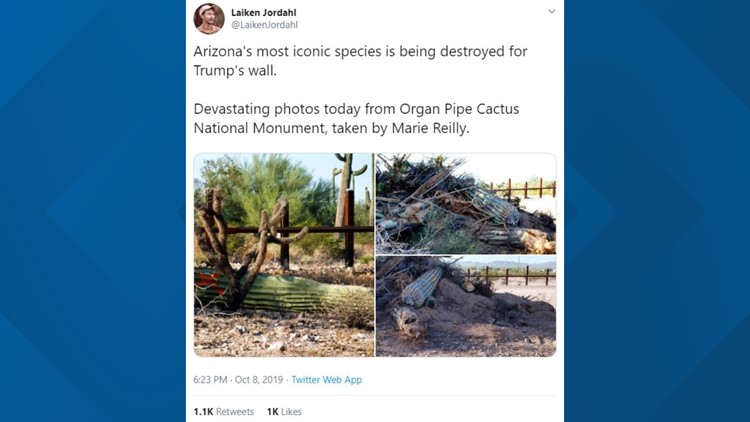TUCSON, Ariz. — U.S. Customs and Border Protection released a statement Wednesday about the recent concern over a video of a saguaro cactus being bulldozed in connection to the construction of a border wall.
Back on Oct. 4, Biological Diversity borderlands campaigner Laiken Jordahl posted the video of the cactus being bulldozed on the Organ Pipe Cactus National Monument land on Twitter. In Joradhl’s video caption, he stated that “Trump’s reckless border hysteria is destroying our environment and killing the very species this national monument was designated to protect.”
In a Facebook post, Kevin Dahl of National Parks Conservation Association, who shot the video, said “a few saguaros are being relocated. Other are being bulldozed.”
Before News 4 Tucson aired the story Saturday evening, reached out to CBP for comment. A statement was not made by the time the story was broadcasted on television.
The following day, CBP released the following statement about the bulldozed cactus.
U.S. Customs and Border Protection (CBP) and the National Park Service (NPS) have a long history of cooperatively managing environmental resources and border security in Organ Pipe Cactus National Monument (OPCNM) and Coronado National Memorial (CNM) in southern Arizona. Over the last 10 years, CBP and NPS have worked closely together to identify strategies for protecting environmental resources within the parks by minimizing the footprint needed for border enforcement activities. These strategies have been effective in not only protecting sensitive biological, cultural, and historical resources within the parks but have also been effective in increasing border security which allowed OPCNM to restore public access to a number of park areas after several years of closure. More than half the monument was closed to the public due to safety concerns from cross border illegal activity such as human and narcotic smuggling. Furthermore, the collaboration between CBP and NPS resulted in the restoration of approximately 111 miles of roads within designated wilderness areas in OPCNM that had deteriorated over time due to cross border illegal activities
This long standing history of collaboration between our two agencies continues today during the construction of new border wall systems and is a critical process in the execution of new projects which will provide the benefit of enhanced border security for both agencies. Prior to and during new border wall system construction, CBP actively engages with federal, state, and local agencies, such as NPS, and other interested stakeholders to ensure that impacts to biological, natural, cultural and historical resources are identified to develop measures that avoid or minimize impacts to the greatest extent possible.
As such, CBP and NPS met during the planning process to discuss appropriate access routes to the border within OPCNM and to identify disturbed areas within the park that could be used for construction purposes. NPS also identified and provided CBP with locations for small wildlife passages within the new border barrier that would allow for the continued passage of small mammals. Most recently, CBP and NPS coordinated on the treatment of archaeological sites identified by NPS in the vicinity of the planned projects in OPCNM and the agencies continue to discuss appropriate mitigation or treatment measures. In addition, CBP and NPS developed strategies to protect and minimize impacts to the Quitobaquito Springs to include no use of groundwater within five miles of either side of the springs.
As part of the continued coordination between NPS and CBP, the agencies collaborated on a vegetation and plant relocation plan to minimize impacts to protected and sensitive plants located within the Roosevelt Reservation. The plan includes the identification and mapping of cacti and other protected plants within and adjacent to the Roosevelt Reservation that could be affected by construction activities including Saguaro Cactus, Organ Pipe Cactus, Ocotillo, Senita Cactus, Barrel Cactus, Hedgehog Cactus, and Agaves. NPS staff are also working to salvage and relocate additional cactus species, including night-blooming cereus cactus. All of the plants listed for relocation are evaluated for health and marked for relocation. Plants determined not to be in a healthy enough state to be relocated are marked as not salvageable and removed from the Roosevelt Reservation. For all plants determined to be salvageable, CBP coordinated with NPS to identify areas within the park where all of these plants could be relocated. To date, a total of 110 plants to include 76 Saguaro, 10 Ocotillo, 1 Senita, 16 Hedgehog, and 7 barrel cactus have been relocated from the Roosevelt Reservation. Relocated plants are monitored for a period of 12 months by a licensed arborist to maximize survivability.



